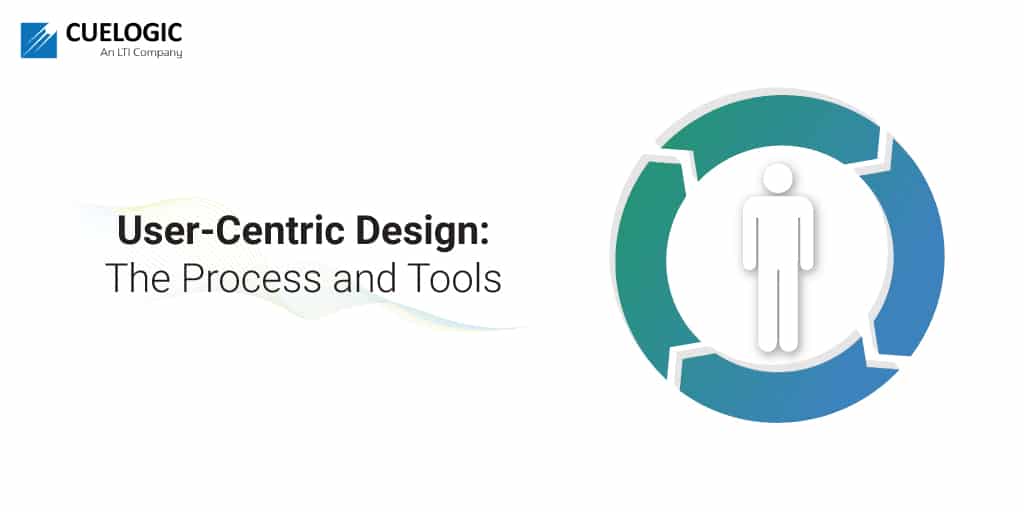What is User-Centered Design?
When designing a product, it’s crucial to understand how and why people will use it. This understanding is integral to creating a product that users will love. User-centric design is about gaining a deep understanding of the users of a product, as well as their motivations for using the product.
But what creates the need for a user-centered design process in the first place?
User-centered design strives to find more effective ways of creating product experiences by leveraging user experience. It does this by first gaining a clear understanding of the people who will use it. This is different from traditional design thinking, which centres around the business goals or product features without taking the end users into account.
The illustrious designer Frank Chimero, who has worked with companies like Nike, famously said, “People ignore design that ignores people.”, which is a succinct way to explain the significance of user-centred design.
The user-centric design paradigm thus aims to create products centred around users’ requirements, wants, and usage.
Why is User-Centered Design Relevant?
The relevance of user-centred design is growing with the emergence of advanced technology in every sphere of human life.
The most cutting-edge of applications can fail to reach mainstream adoption if not designed in accordance with a customer’s usage. Devices that revolutionized the world like the iPod and the iPhone did not become so immensely popular based solely on the technology; what set them apart was the fact that they were created while keeping the customer in mind at every stage.
The latest innovations in technologies like Augmented Reality (AR) and the blockchain can completely change consumers’ lives. However, the first roadblock is in making them implicitly usable and understandable by everyone. This is where technology and user-centered design meet, and the former cannot succeed without the latter.
User-centered design makes the latest technology accessible to all users and implicitly helps users determine which products and experiences they would return to. In simple words, user-centered design is the key to a successful product.
The Principles of User-Centered Design
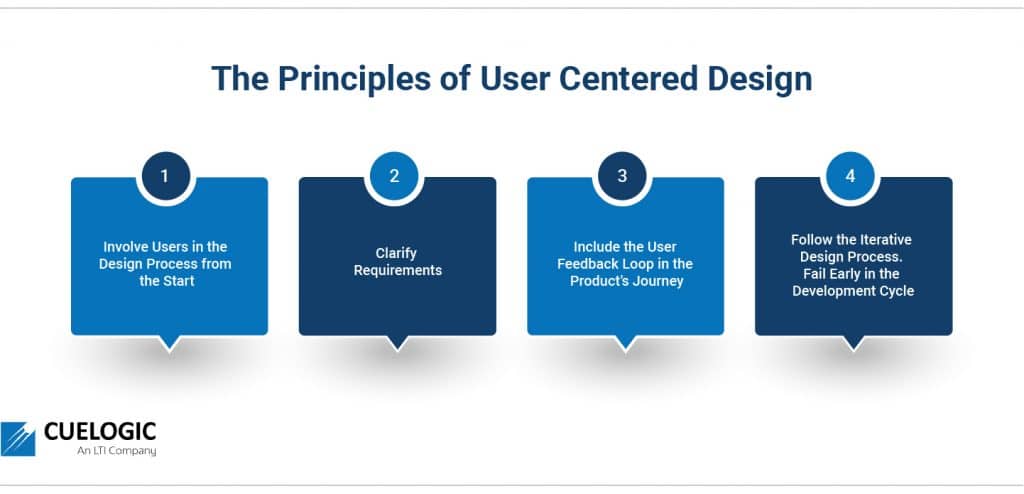
There are four core principles that need to be considered while implementing user-centered design successfully. They are:
1. Involve Users in the Design Process from the Start
Critical design decisions need to be based on how they work for end-users. To ensure that a product meets user needs, users need to be involved from the beginning of a project’s life cycle. Product designers may often not be able to understand minor preferences that are apparent to users from their perspective, and the minor points can often be the differentiating factor.
2. Clarify Requirements
Albert Einstein once said, “If I had an hour to solve a problem and my life depended on the solution, I would spend the first 55 minutes determining the proper question to ask, for once I know the proper question, I could solve the problem in less than five minutes.”
This quote from Albert Einstein reflects a vital part of the product design process: understanding the problem statement. Product teams should prioritize this phase of the product development journey, and set aside sufficient time for this phase.
3. Include the User Feedback Loop in the Product’s Journey
User interviews and feedback help the team make more user-focused decisions and any corrections, if needed, earlier in the product’s life-cycle. The perspective of real end-users is of utmost significance in the user-centric design process, and so the feedback loop is the most critical step to follow.
4. Follow the Iterative Design Process. Fail Early in the Development Cycle
Since user input is included at every stage, the team should plan their efforts at every stage to include the newest recommendations. Then, release cycles with updates can be planned as per priorities. Finally, the team iterates over the phases until the feedback results are deemed satisfactory, and the product can be released in the market.
User-Centered Design Process
To implement the user-centered design paradigm well, teams go through several steps in the product design phase. These steps can be summarised as:
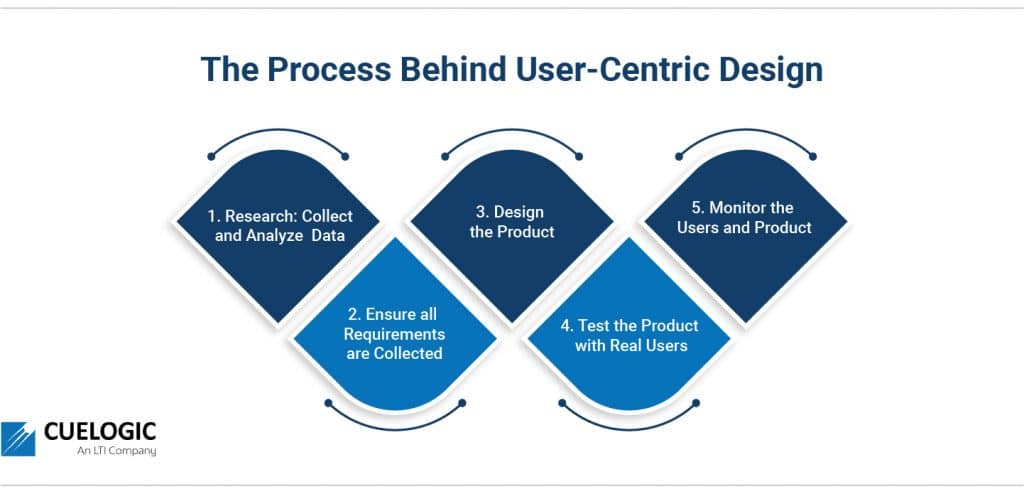
1. Research: Collect and Analyze Data
As a means to gather all the required data about users, teams can create personas, scenarios, and use-cases with their target audience in mind.
Personas:
Personas are a way of creating a fictional character by summarizing the target audience for a product.
For instance, if a team is launching a product for a specific group, first they would understand which market segment or working group is to be studied.
Once they know the target group to study, they would try to find answers to certain fundamental questions:
- What is the product aiming to do for the group?
- What impact is the product intended to have on the market?
- How can the product’s success be measured?
Once the data from the group is collected, it must be analyzed. It is important to look for trends within and between groups at this stage. This is important as personas need to describe groups as a whole without too much weightage given to edge cases.
Finally, the data about the group can be summarised in the form of a persona. This helps teams determine requirements, decide design direction, and increase the chances of creating a successful product.
Scenarios:
A scenario can be thought of as a sequence of events that occur with the product’s user. The ‘persona’ created after market research should be used as the main character of this story. Scenarios should be designed to learn about the different outcomes of an event: there can be the best-case scenario, where everything works out ideally for the main character, the worst-case scenario, where nothing works out, and an average-case scenario, which is a regular day in the life of the character, where nothing special occurs.
Use-Cases:
A use case describes the interaction between the persona and the rest of the world. It represents an event that may consist of intricate interactions between the character and the world. It is depicted by a series of simple steps for the character to achieve a goal in a cause and effect pattern.
2. Ensure all Requirements are Collected
Once the context is understood, the team must identify the granular requirements of the product. This is a critical phase that allows the use of storyboards and also includes determining metrics for success. This phase involves close interactions with the users to refine and fine-tune the requirements to align with business goals.
3. Design the Product
Based on product goals and requirements, an iterative process of product design and development can be conducted. Teams can choose between following a waterfall model, agile model, or any other software engineering practice.
User-centered design is executed best when a multidisciplinary team participates in the design process. A team that has members with different backgrounds and from different disciplines can produce more creative design decisions. The team must ensure that no non-validated personal opinions (or personal bias) enter the product during the design phase. Every design decision should be implemented based on the information about the users and validated during the requirement gathering.
During the early stages of product development, the product can be designed as a wireframe for user testing.
4. Test the Product with Real Users
Once the product is designed, it undergoes usability testing to get users’ feedback.
Usability testing helps teams understand what problems users face when interacting with the product, and helps teams optimize the product before releasing the product to wider markets.
5. Monitor the Users and Product
When a product is launched, it needs to be monitored to see the desired impact. Also, while looking at the qualitative indicators, tracking the performance and getting user feedback is necessary.
Observation is a powerful technique for collecting qualitative insights about users. It is a user-research technique that involves observing and interviewing people while performing tasks in context. The person who conducts a contextual inquiry observes how participants perform their tasks and has them talk about what they are doing while interacting with a product.
Tools Used for User-Centered Design
Since the user-centered design paradigm involves having a profound knowledge of the user, this discipline goes hand in hand with techniques and tools that enable teams to gather this information.
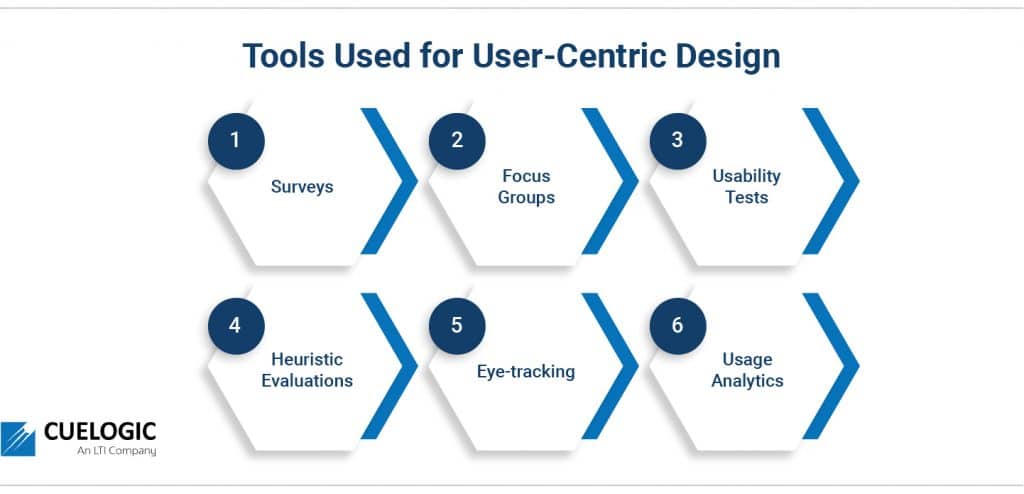
Product teams use the following tools to learn about customers:
1. Surveys
A questionnaire or quantitative survey is a type of user research that asks users a pre-defined set of questions and analyses their responses. Surveys are a good way of generating statistical data.
Questionnaires are usually needed when a design team:
- Cannot physically interact with the targeted users of a product
- Requires a larger sample size than can be realistically achieved through direct communication
Hence, surveys are usually conducted through post or electronic means. Since surveys allow statistical analysis of results, they can increase a study’s credibility. Therefore, it is crucial to ensure the questionnaire is well thought out and asks non-biased questions.
2. Focus Groups
A focus group involves a dedicated group of intended/actual users of a product who come together to share their thoughts and ideas on a particular subject. Focus groups are suitable for getting information about a domain (e.g. what people’s tasks involve).
Focus groups necessitate assigning an experienced moderator from the product domain. Since the group has enthusiasts about the product, focus groups are invaluable in UCD.
3. Usability Testing
Usability testing sessions evaluate a product by collecting data from people using it. For the test, a user is asked to perform various tasks while a moderator observes them and notes their experience.
Users can be asked to think out loud as they complete the tasks while describing what they’re doing and why they’re doing it.
Users can also be timed to see how long they take to complete tasks, which helps measure efficiency (however, the ‘think aloud’ protocol may slow users down significantly).
Usability tests require some type of design to be available to test, even if it’s only on paper.
Usability tests can be used as an input to design or at the end of a project. It helps identify the most probable usability problems with a product.
4. Heuristic Evaluations
A group of usability experts evaluates the product against a list of established guidelines. For instance, a common heuristic used in calculating the level of ‘user control’ in a product- users appreciate having the chance to quit an application or flow at any stage. Another heuristic would have relevant help and documentation for the product to enable users to use the product without any errors.
5. Eye-tracking
Eye-tracking is a technology tool that measures eye movements and captures where a person is looking on the screen and for how long their gaze is in a particular spot. Eye-tracking allows teams to track usability patterns without disturbing natural user behavior. For example, teams can identify how users scan pages, what patterns they follow, and which elements get the most user attention.
Heatmaps can be designed to display where the most users focus. A heat map is created based on fixations— spots where participants look for 100 to 500 ms. Teams can also devise ‘Gaze point plots’. These allow the product teams to see what elements interest the users and the order in which the user looks at them.
6. Usage analytics
Usage analytics include testing methods focused on navigation, which can be performed on a functioning website, a prototype, or a wireframe. Teams can track Unique screen views, time spent on each screen and event, understand which features are the most important to users, and which features need to be optimized.
Points to be careful of:
While the user-centered design is an excellent design paradigm to follow, with guaranteed higher chances of the product being successful, a few areas need to be focused on to ensure it is executed correctly.
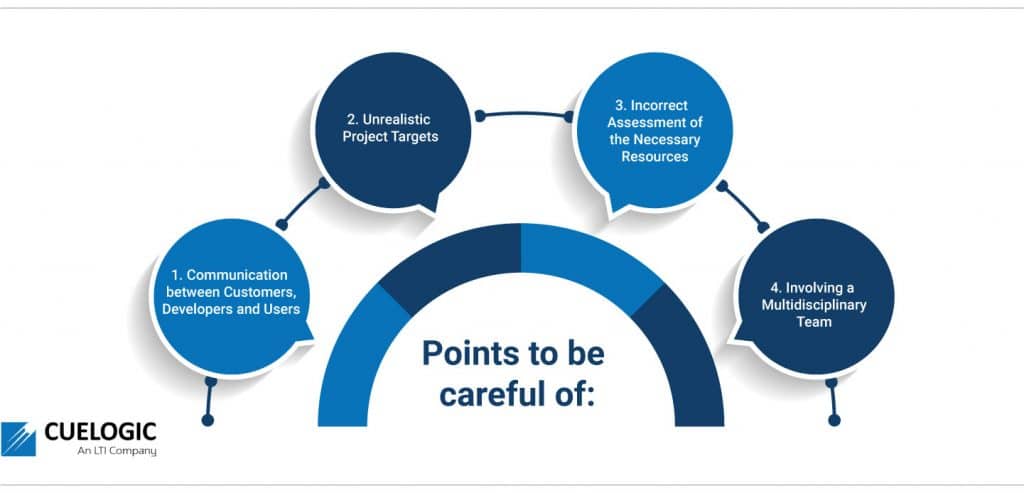
1. Communication between Customers, Developers and Users
Getting honest feedback from the users and allowing the developers to voice their concerns about realistic targets helps businesses be explicit about the features that can be delivered successfully.
Setting up honest, approachable communication points of contact is the most essential aspect of UCD.
2. Unrealistic Project Targets
Often with User-Centered Design, teams may expect a product to deliver beyond the possible outcomes. However, teams need to acknowledge that even though they worked on a product in a specific domain, many more factors come into the success of a product. For instance, product update deadlines are a topic that is extremely significant to a product’s success, but this is not something that User-Centered Design can determine.
3. Incorrect Assessment of the Necessary Resources
A common pain point for UCD teams is determining the resources to complete a given list of tasks. In addition, since User-Centered Design involves maturing product backlogs with user feedback, teams need to revise their estimated resources constantly.
4. Involving a Multidisciplinary Team
In User-Centered Design, projects are based upon an explicit understanding of the users, tasks and environments. The product designers focus and aim is to address the whole user experience. Therefore, the design team should include members from across multiple disciplines (e.g., psychologists, software and hardware engineers) and domain experts, stakeholders, and the users themselves.
A Success Story: User-Centered Design Examples
A company that saw measurable success after implementing User-Centered Design is Airbnb. As you may know, Airbnb allows people to sublet their houses to travelers. This revolutionary idea has significantly impacted the traditional hotel hospitality industry. The app takes inputs in a very humane way, allowing users to input their preferred dates as “a weekend in October” or “a week in November”, much in the way people plan their travel.
The founder of Airbnb, Brian Chesky, wanted to understand the Airbnb customer experience as the company planned its expansion and used storyboarding techniques to do so. The use cases developed by Airbnb documented the Airbnb experience from different user perspectives. Airbnb hired the famous Pixar animator Nick Sung to document the final copies of three stories:
- the host process,
- the guest process,
- and the hiring process.
They even went so far as to conjecture what the hosts could do with the extra income. User-centric design guided marketing, advertising, and customer service decisions at Airbnb. A tangible result of these visualized scenarios was that Airbnb expanded its mobile app services by including features such as instant messaging between the host and guest, which are now indispensable to their offering.
Benefits of Incorporating User-Centric Design
The user-centric concept has found its way into the business strategies of companies the world over for the several benefits it offers:
- With close user involvement, products are more likely to meet users’ expectations and requirements. This leads to increased sales and lower costs incurred by customer services.
- A product built with users at the centre leads to increased loyalty and an elevated reputation for the business brand.
- The rigorous usability tests ensures that systems designers tailor products for people after observing their usage patterns, thereby reducing the chances of situations with a high risk of human error arising. Hence, user-centred design leads to safer products.
- Save business time and money. Testing things with end-users when it is still cost-effective to make changes reduces the cost of re-work required in projects.
- Putting user-experience (UX) designers in close contact with various users means a more profound empathy for diversity emerges. This is essential in creating products that cater to humans with varying levels of exposure to similar products.
Conclusion
Being human-centred adds costs to projects, so businesses often tend to ask whether taking the much time to talk to people, produce prototype designs and refine the product as per the user feedback is worth the effort. The answer is an inevitable’ yes’ due to the increased success in user-centred design projects. As companies continue to strive for increased efficiency and effectiveness, user-centred design will only become more prevalent. By understanding the needs of their customers and designing products with the end-users in mind, businesses can improve the customer experience and continue to push sales and loyalty.
